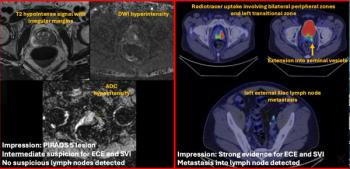
Spine Radiology Insights on Venous Fistula Localization and Finding Cerebrospinal Fluid Leaks
In a recent lecture at the American Roentgen Ray Society (ARRS) 2023 Annual Meeting, Andrew Callen, M.D., discussed a variety of imaging features associated with cerebrospinal fluid (CSF) leaks, the diagnostic utility of the Bern score as well as the merits of 3D T2FS MRI and dynamic computed tomography myelography.
Addressing the challenges of diagnosing cerebrospinal fluid (CSF) leaks, Andrew Callen, M.D., reviewed key imaging considerations and the advantages of emerging modalities such as three-dimensional T2-weighted, fat-suppressed magnetic resonance imaging (3D T2FS MRI) during a recent lecture at the
Here are a few pertinent takeaways.
1. While diffuse dural enhancement on brain MRI may be mischaracterized with other diagnoses such as pachymeningitis, Dr. Callen said it is the most recognizable feature of intracranial hypovolemia.
“Diffuse, smooth, circumferential dural enhancement is almost always CSF hypovolemia,” maintained Dr. Callen, an assistant professor of neuroradiology and director of the CSF Leak Program at the University of Colorado.
2. Superficial siderosis may originate from a spinal dural defect, which leads to subsequent accumulation of CSF in the epidural space, repeated microtrauma to the epidural venous plexus and circulation of hemosiderin into the subarachnoid space, according to Dr. Callen. While noting that superficial siderosis may be the least intuitive of the findings for spontaneous intracranial hypotension (SIH), Dr. Callen cautioned that superficial siderosis can be a separate clinical syndrome with symptoms including pyramidal signs, ataxia, and hearing loss.
3. Citing a recent meta-analysis, Dr. Callen noted that 19 percent of patients with a proven CSF leak may have a “normal” brain MRI.1
4. The Bern score, which determines the likelihood of a CSF leak in a patient with suspected SIH, has “incredible practical utility,” according to Dr. Callen. He said the scoring system is based on the presence of one or more of six MRI diagnostic signs, including pachymeningeal enhancement, subdural collection and less than or equal to 6.5 mm of mamillopontine effacement.
In a recent publication, Dr. Callen and his colleagues found that in comparison to a blinded expert reader, there was much less discordance with the Bern score, noting a 27 percent improvement in diagnosing findings of SIH.2 Dr. Callen also noted there was a significant reduction in false negatives in characterizing the probability of finding CSF leaks and no false positives.
5. Dr. Callen emphasized that normal CSF opening pressure doesn’t rule out CSF leaks. He noted that multiple studies have shown no difference in CSF pressure between those with CSF leaks and those without.3,4
(Editor’s note: For related content, see “
6. For the characterization of epidural fluid collection, Dr. Callen said 3D T2FS MRI provides “well-tailored MRI sequences” that provide advantages over conventional computed tomography (CT) myelography. The benefits of 3D T2FS MRI include much less CSF flow artifact, inclusion of axial T2 FS MRI, which isn’t included in conventional spine MRI protocols, and heavy T2 weighting, which allows assessment for for subtle fluid signal, according to Dr. Callen.
7. For CSF venous fistulas, Dr. Callen noted that dynamic CT myelography offers key benefits. In comparison to conventional CT myelography. dynamic CT myelography utilizes decubitus positioning that facilitates a pressure gradient using gravity from the CSF compartment to the venous compartment and allows the use of provocative maneuvers to help increase the conspicuity of CSF venous fistulas, according to Dr. Callen.
Another advantage with dynamic CT myelography is the acquisition of imaging shortly after injection as opposed to the delayed imaging with conventional CT myelography.
“Using very fast imaging in multiple phases, we can increase our chances of catching a CSF venous fistula,” emphasized Dr. Callen. “They can be very fleeting and sometimes we’ll only see them on that early phase.”
References
1. D’Antona L, Merchan MAJ, Vassiliou A, et al. Clinical presentation, investigation findings, and treatment outcomes of spontaneous intracranial hypotension syndrome: a systematic review and meta-analysis. JAMA Neurol. 2021;78(3):329-337.
2. Turner R, Zander D, Thaker AA, Timpone VM, Callen AL. Structured reporting for findings of spontaneous intracranial hypotension on brain MRI. AJR Am J Roentgenol. 2023 Mar 15. doi: 10.2214/AJR.23.29144. Online ahead of print.
3. Luetmer PH, Schwartz KM, Eckel LJ, Hunt CH, Carter RE, Diehn FE. When should I do dynamic CT myelography? Predicting fast spinal CSF leaks in patients with spontaneous intracranial hypotension. AJNR Am J Neuroradiol. 2012;33(4):690-4.
4. Callen A, Pattee J, Thaker AA, et al. Relationship of Bern score, spinal elastance, and opening pressure in patients with spontaneous intracranial hypotension. Neurology. 2023 Apr 4. doi: 10.1212/WNL.000000000207267. Online ahead of print.
Newsletter
Stay at the forefront of radiology with the Diagnostic Imaging newsletter, delivering the latest news, clinical insights, and imaging advancements for today’s radiologists.




























